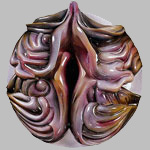Feminism

Today, we look at women artists. And not just artists who are women, but women who make art because they are women. We’ve actually seen women artists already, but less than a quarter of the artists we’ve seen so far happen to be women. The artists we see today are not so happy about a woman’s marginalized role in society. They are not content to play the game against the odds and hope that they will be welcomed into a man’s world. So, how do they go about trying to change the game?
We look today at several strategies, and methods, of trying to play outside the rules. Unlike many of the previous lectures, these artists do not constitute a particular style, or chronology, as much as they all are interested in a particular objective. They want to make sure that women are given their just place in the art world, and the world in general. To do this, they employ several strategies, and today we try to loosely group these artists not by time or style, but by common strategy.
First, we look at women taking on stereotypically male roles in order to construct their artistic identity. So far we have been seeing women artists doing just that, trying to fit in and play a man’s game according to man’s rules. Today though, these artist’s make the gender role apparent, and discomforting. Niki de Saint Phalle, after playing the role of the beautiful model, the object to adore, changes course and begins shooting guns at artworks in a destructive act of creativity. Taking on male aggression and turning it into a form of self-therapy that violates the canvas, she says “In 1961 I shot at: Daddy, all the men, small men, tall men, important men, fat men, men, my brother, society, church, school, my family, my mother, all the men, Daddy, myself, men again.” She then turns to the most traditional female role, that of the mother, in her Nana series. Linda Benglis, as much as her artwork fits what is expected of a 1970’s process artist, posts humorously obscene ads in Artforum that challenge our ideas of both masculinity and femininity.
Next we look at artists who don’t just try to play the game, but actually tell the men in charge that they aren’t invited to the party. We start with Womanhouse by Miriam Schapiro and Judy Chicago. Here, women artists were invited to create installations in a home where men were not allowed to tread, at least until after the opening day. This questioned whether the course of art so far, one determined by men and made by men, even deserved the attention of women, who could create their own, parallel history.
At this point, we start to examine the role of questioning authority. Nancy Spero challenges the powers that be, not just in terms of woman’s issues, as in pieces like Torture of Women, but governmental roles in general in the oppression of the masses. And we look at the Guerilla Girls, anonymous women artists, who create political pieces that examine the horrifying fact that the artworld, of all places, is even more backwards and resistant to women’s rights than mainstream America.
In the next few sections we look at the concept of power, and where power resides. We start with the body as a point of power, and women who look to use their bodies to exhibit this power. This is tricky territory, as women’s bodies are traditionally subject to objectification, and to seduce with an image of one’s body quickly plays into this. So how do they try to overcome this obstacle? Carolee Schneeman, starts with videotaped performances of bodies writhing in piles of meat, her body covered with sculptural materials as if she were herself a canvas. Then, in her most famous work, pulls a scroll from her vagina that confronts a film critic who has told her the messy feminine and emotional esthetic of her films makes them unwatchable. Hanna Wilke tries through various means to objectify herself and the female body while adding aggressive elements like guns, prosthetic wounds, and maladies to distance the viewer and bring humanity back to the body. She posses in pinup fashion covered with little sexual organs made of chewing gum attached all over her body and sais ““I chose gum because it’s the perfect metaphor for the American woman – chew her up, get what you want out of her, throw her out and pop in a new piece,.” When she herself succumbs to lymphoma at the age of 53, she documents her deterioration and forces the viewer to see women not just as objects but also as human.
As much as the body is a place of power, so is the voice, and this is explored by artists such as Barbara Kruger and Jenny Holzer. Kruger uses the language to consumer advertisements and cold war propaganda to lambaste the viewer for their complicity in male power. Jenny Holzer explores many voices through her truisms, and finds various artistic media with which to display these thoughts. Her piece Detained, from 2008, displays “redacted” documents obtained through the freedom of information act. These documents detail the controversial treatment of prisoners in Guatanamo. Throughout the documents, text has been blacked out before the report was made public, showing that we still live in world which fears the power of the voice.
Finally we look at the gaze as a source of power. Just by looking, by confronting the viewer, the artists gains power. We see this today throughout this lecture, when photographs of artists depict themselves looking straight back at us. Sophie Calle is one example of an artist who takes this to an extreme, as she becomes the voyeur, following people unsuspecting through the streets, or photographing their possessions when they are out of their hotel rooms. Sue Williams shows us that knowing what to look for is as important as the looking. Her seemingly innocent abstract paintings take on a new level of meaning once we know that within the gestures are hidden sexual organs and exploded body parts, challenging notions of sexuality and violence.
After this class you should be able to
Define the following:
- feminism
- the gaze
- hegemony
Recognize artwork by the following artists:
- Linda Benglis
- Sophie Calle
- Judy Chicago
- Guerrilla Girls
- Jenny Holzer
- Barbara Kruger
- Sarah Lucas
- Ana Mendieta
- Carolee Schneemann
- Nancy Spero
Be familiar with the following artists:
- Marina Abramovic
- Tracy Emin
- Niki De Saint Phalle
- Miriam Schapiro
- Sue Williams
- Hannah Wilke
Answer the following:
What was Womanhouse? What is The Dinner Party?
Which artist compiled lists of text that she called Truisms?
Which of these artist’s work also fits into other movements that we have studied?
External Links for further reading:
A good post on Niki de Saint Phalle Judy Chicago’s website The Dinner Party at the Brooklyn Museum Nancy Spero’s Obituary in The Guardian Off topic — Young Women Set Vocal Patterns
